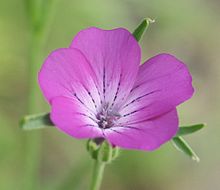
Caryophyllaceae, commonly called the pink family or carnation family, is a family of flowering plants. It is included in the dicotyledon order Caryophyllales in the APG III system, alongside 33 other families, including Amaranthaceae, Cactaceae, and Polygonaceae. It is a large family, with 81 genera and about 2,625 known species.

Papaver rhoeas, with common names including common poppy, corn poppy, corn rose, field poppy, Flanders poppy, and red poppy, is an annual herbaceous species of flowering plant in the poppy family Papaveraceae. It is native to north Africa and temperate Eurasia and is introduced into temperate areas on all other continents except Antarctica.

Chamaenerion angustifolium is a perennial herbaceous flowering plant in the willowherb family Onagraceae. It is known in North America as fireweed and in the British Isles as rosebay willowherb. It is also known by the synonyms Chamerion angustifolium and Epilobium angustifolium. It is native throughout the temperate Northern Hemisphere, including large parts of the boreal forests.
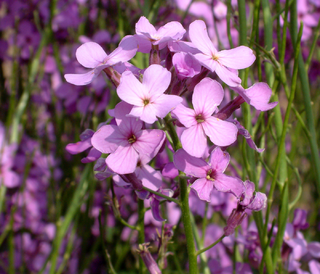
Hesperis matronalis is an herbaceous flowering plant species in the family Brassicaceae. It has numerous common names, including dame's rocket, damask-violet, dame's-violet, dames-wort, dame's gilliflower, night-scented gilliflower, queen's gilliflower, rogue's gilliflower, sweet rocket, and mother-of-the-evening.

A wildflower is a flower that grows in the wild, meaning it was not intentionally seeded or planted. The term implies that the plant is neither a hybrid nor a selected cultivar that is any different from the native plant, even if it is growing where it would not naturally be found. The term can refer to the whole plant, even when not in bloom, and not just the flower.
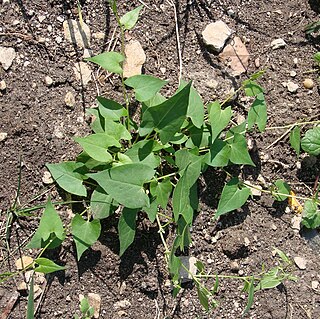
Fallopia convolvulus, the black-bindweed or wild buckwheat, is a fast-growing annual flowering plant in the family Polygonaceae native throughout Europe, Asia and northern Africa.

Agrostemma is a genus of annual plants in the family Caryophyllaceae, containing the species known as corncockles. Its best-known member is A. githago, the common corncockle, which is a native of Europe. The species is a weed of cereals and other crops, probably with a centre of origin in the eastern Mediterranean. It occurs as a weed worldwide, but is declining in its native range because of improved seed cleaning. Agrostemma gracile, the slender corncockle, is only found in central Greece near the city of Farsala. Corncockle is an attractive plant, and its seeds are still commercially available to gardeners.

Lobularia maritima is a species of low-growing flowering plant in the family Brassicaceae. Its common name is sweet alyssum or sweet alison, also commonly referred to as just alyssum.

Lathyrus japonicus, the sea pea, beach pea, circumpolar pea or sea vetchling, is a species of flowering plant in the legume family Fabaceae, native to temperate coastal areas of the Northern Hemisphere, and Argentina.

Consolida regalis, known as forking larkspur, rocket-larkspur, and field larkspur, is an annual herbaceous plant belonging to the genus Consolida of the buttercup family (Ranunculaceae).
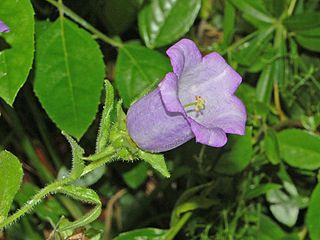
Campanula medium, common name Canterbury bells, is an annual or biennial flowering plant of the genus Campanula, belonging to the family Campanulaceae. In floriography, it represents gratitude, or faith and constancy.

Euphorbia lathyris, the caper spurge or paper spurge, is a species of spurge native to southern Europe, northwest Africa, and eastward through southwest Asia to western China.
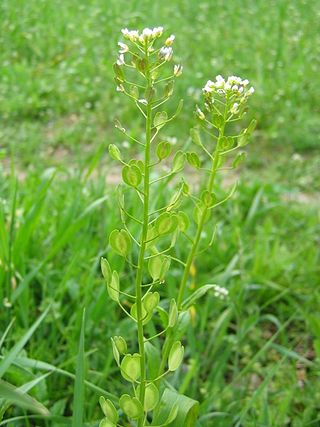
Thlaspi arvense, known by the common name field pennycress, is a flowering plant in the cabbage family Brassicaceae. It is native to Eurasia, and is a common weed throughout much of North America and its home.

Sabatia angularis, commonly called rosepink, rose pink, square-stem rose pink or rose gentain is a biennial flowering plant in the Gentianaceae (gentain) family. It is native to central and eastern North America.

Scrophularia nodosa is a perennial herbaceous plant found in temperate regions of the Northern hemisphere except western North America. It grows in moist and cultivated waste ground.

Lathyrus sylvestris, the flat pea or narrow-leaved everlasting-pea, is a species of flowering plant in the pea and bean family Fabaceae. It is native to parts of Africa, Europe, and Asia.
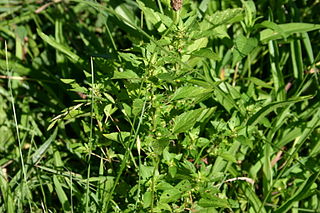
Acalypha rhomboidea is a plant in the spurge family, Euphorbiaceae.

Spergularia media is a species of flowering plant in the family Caryophyllaceae known by the common names media sandspurry and greater sea-spurrey. It is native to Eurasia and the Mediterranean, where it grows in many types of habitat, including disturbed areas, including places with saline substrates, such as salt marshes and beaches. It is known in many other parts of the world as an introduced species and a common roadside weed. In North America it is a "highway halophyte", often springing up at the margins of roads that are heavily salted in the winter.
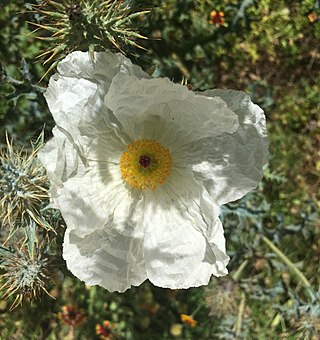
Argemone albiflora, the white prickly poppy, also known as the bluestem prickly poppy or the Texas prickly poppy, is a small erect plant with a decorative white flower with a yellow latex. It is deeply rooted with yellow or red stamens. The plant is known for the sharp prickles on its stem and leaves. The sepals fall off as the flower of this plant grows bigger. It grows in the arid regions of the southern Midwest along roadsides and disturbed pieces of land. Native Americans have long revered this plant for its medicinal and other uses.
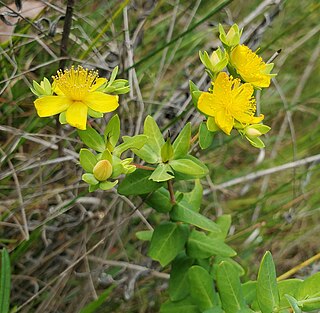
Hypericum myrtifolium, the myrtleleaf St. Johnswort, is a species of flowering plant in the St. John's wort family, Hypericaceae. It is endemic to the Southeastern United States. It was first described by Jean-Baptiste Lamarck in 1797.
